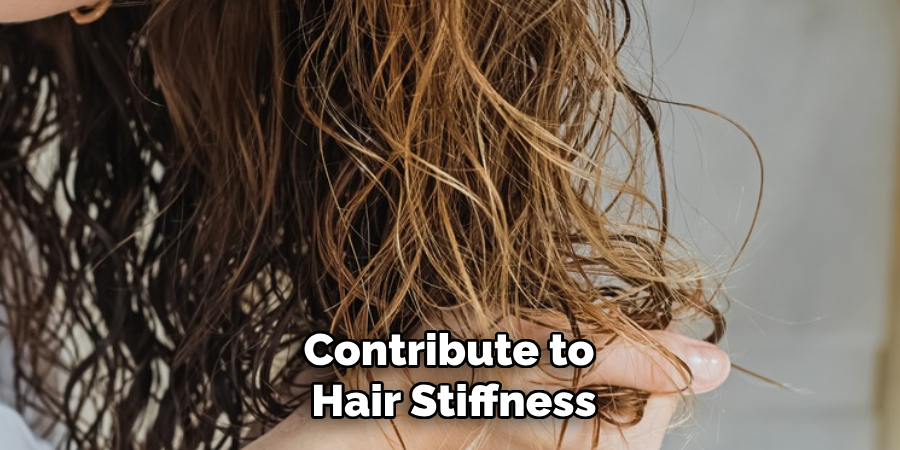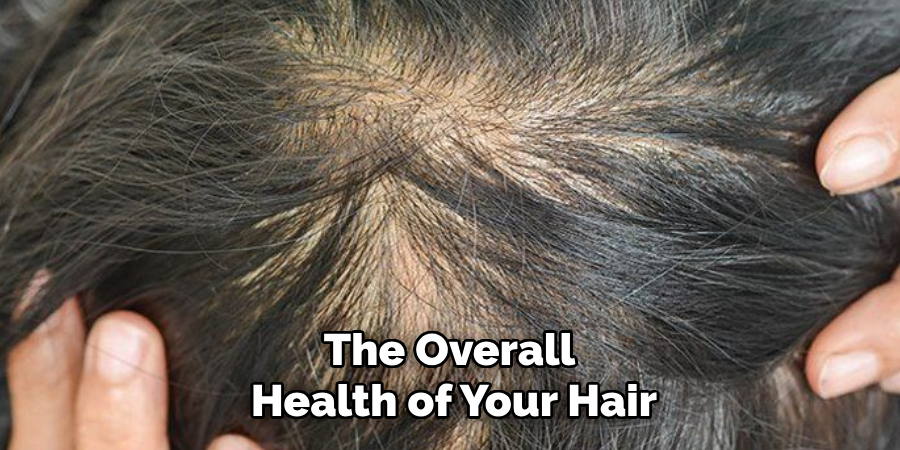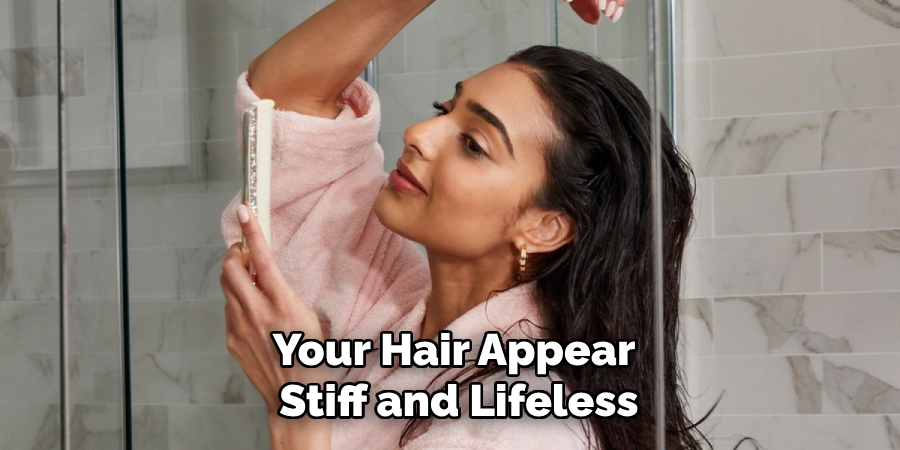Are you tired of dealing with stiff, unmanageable hair? Do you dream of having soft and flowy locks that are easy to style? If so, then this guide is for you!

If your hair tends to be stiff and lacks movement, don’t worry! Various methods and techniques can help you achieve softer and more flexible hair. Whether your hair is naturally rigid or has become stiff due to external factors, this article will guide you through practical strategies to make your hair less stiff.
By incorporating these tips on how to make hair less stiff, you can enjoy hair that is more manageable, bouncy, and full of life. So, let’s dive in and discover how to transform your stiff strands into silky-smooth locks.
What Are the Benefits of Having Less Stiff Hair?
Here are some of the benefits of making your hair less stiff:
- Better Manageability: Soft and flowy hair is more straightforward to style and manage than stiff and unyielding hair.
- Natural Movement: Flexible hair has natural movement that looks effortless and adds volume to your overall look.
- Reduced Damage: When hair is too stiff, it can easily break or become damaged during brushing or styling. Softer hair is less prone to damage.
- Improved Texture: Soft hair has a smoother texture and is more touchable, making it look and feel healthier.
- Versatility: With less stiff hair, you have more options for hairstyles. You can create tousled looks, loose curls, or sleek straight styles without much effort.
Now that you know the benefits of having less stiff hair, let’s explore some techniques for achieving softer and more flexible locks.
What Will You Need?
You may need a few products and tools to make your hair less stiff. Here are some essentials that can help you achieve the desired results:
- Moisturizing Shampoo and Conditioner: The first step to achieving softer hair is using a moisturizing shampoo and conditioner. Look for products with nourishing ingredients like argan oil, coconut oil, or shea butter.
- Leave-In Conditioner: A leave-in conditioner can provide extra hydration to your hair, helping to combat stiffness.
- Deep Conditioning Treatment: If your hair is highly stiff and dry, consider using a deep conditioning treatment once a week to restore moisture and flexibility.
- Wide-Tooth Comb or Detangling Brush: These tools can help you detangle your hair without causing damage or breakage.
- Heat Protectant: If you use heat styling tools, a heat protectant is essential to prevent further damage and keep your hair soft.

10 Easy Steps on How to Make Hair Less Stiff
Step 1: Wash Your Hair
Start by thoroughly wetting your hair with lukewarm water. Apply a moisturizing shampoo and gently massage it into your scalp using your fingertips. Focus on the roots to remove any dirt, oil, or product buildup. Rinse your hair thoroughly with water until all the shampoo is washed out.
After shampooing, follow up with a nourishing conditioner. Apply the conditioner from mid-length to the ends of your hair, avoiding the scalp. Allow the conditioner to rest for a few minutes to deeply hydrate your hair. Use a wide-tooth comb or your fingers to detangle any knots or tangles gently. Finally, rinse your hair with cool water to seal the cuticles, leaving your hair soft and manageable.
Step 2: Apply a Hydrating Hair Mask
Once a week, treat your hair to a deep conditioning hair mask to combat stiffness further. Choose a hydrating mask suitable for your hair type. Apply the mask to damp hair, focusing on the mid-length to the ends. Leave it on for the recommended time, allowing the nourishing ingredients to penetrate your hair strands. Rinse thoroughly and enjoy the added moisture and softness.
Step 3: Opt for a Leave-In Conditioner
After washing your hair, apply a leave-in conditioner to provide ongoing hydration and protection. This lightweight product helps seal moisture and prevent your hair from becoming stiff or dry throughout the day. Apply a small amount to your damp hair, focusing on the ends, and comb through to distribute the product evenly.
Step 4: Limit Heat Styling
Excessive heat styling can contribute to hair stiffness. Minimize using hot tools such as straighteners, curling irons, and blow dryers. When using heat styling tools, always apply a heat protectant spray to shield your hair from damage. Embrace natural hairstyles or opt for heatless styling methods to give your hair a break from excessive heat.

Step 5: Protect Your Hair While Sleeping
Your sleeping routine can significantly impact the texture and softness of your hair. To prevent your hair from becoming stiff or tangled while you sleep, consider using a satin or silk pillowcase instead of a cotton one. The smooth surface of satin or silk reduces friction, preventing hair breakage and frizz.
Additionally, you can braid your hair loosely or tie it in a loose bun before bedtime to minimize tangling. Wear a silk or satin bonnet or wrap your hair in a silk scarf for extra protection. Taking these small steps can help maintain your hair’s softness and flexibility overnight.
Step 6: Avoid Harsh Hair Products
Certain hair products containing sulfates, parabens, or alcohol can strip your hair of its natural oils, making it dry and stiff. Opt for gentle, sulfate-free shampoos and conditioners formulated for dry or damaged hair. Avoid using products with high alcohol content, as they can worsen stiffness over time.
Instead, use hair care products enriched with natural oils, proteins, and vitamins to nourish and strengthen your hair. Reading labels and choosing high-quality products can make a significant difference in achieving softer, healthier hair.
Step 7: Incorporate Hair Oils
Lightweight hair oils such as argan oil, jojoba oil, or almond oil can work wonders for stiff hair. After styling or as part of your morning routine, apply a small amount of oil to the mid-lengths and ends of your hair. This helps lock in moisture, add shine, and keep your hair soft and smooth.
You can also use oils as a pre-shampoo treatment by massaging them into your hair and scalp, then letting it sit for 20-30 minutes before washing. This deep-nourishing method can restore flexibility and improve the overall health of your hair.

Step 8: Stay Hydrated and Maintain a Balanced Diet
Your hair reflects your overall health, so staying hydrated and nourishing your body with a balanced diet is essential. Drink plenty of water daily to keep your hair hydrated from within. Include foods rich in vitamins and minerals, such as biotin, E, and omega-3 fatty acids, promoting healthy, flexible hair.
A holistic approach to your hair care routine, including proper nutrition, can enhance the effectiveness of external treatments and leave you with soft, manageable locks.
Step 9: Trim Split Ends Regularly
Split ends can make your hair look stiff and unhealthy. Schedule regular trims with your hairstylist every six to eight weeks to remove split ends and maintain the overall health of your hair. Keeping your ends smooth and free of damage will enhance your hair’s natural flow and softness.
Step 10: Be Patient and Consistent
Achieving softer, less stiff hair requires time and a consistent effort. Remember that results might take time, but with patience and adherence to these steps, you will gradually notice a positive difference in your hair’s texture and manageability. Stick to a regular hair care routine, and don’t hesitate to tweak or adjust it based on your hair’s needs. Over time, your dedication will pay off, leaving your hair feeling healthier, softer, and more supple.
By following these easy steps and adopting a consistent hair care routine, you can transform stiff hair into soft, flowy locks that are healthy and full of life.
5 Things You Should Avoid
- Overwashing: Washing your hair too frequently can strip away its natural oils, leaving it dry and stiff. Aim to wash your hair every other day or every few days, depending on your hair type.
- Using Harsh Chemicals: Avoid hair products containing harsh chemicals, such as sulfates and alcohol. These ingredients can strip away moisture and make your hair stiff and brittle.
- Excessive Heat Styling: Exposing your hair to excessive heat from styling tools like flat irons, curling irons, and blow dryers can damage the hair cuticle and make it more prone to stiffness. Limit heat styling tools, and always use a heat protectant spray before styling.
- Tight Hairstyles: Wearing tight hairstyles, such as tight ponytails or buns, can strain the hair follicles and lead to stiffness. Opt for looser hairstyles that allow your hair to move and breathe.
- Skipping Regular Trims: Regular trims are essential for maintaining healthy hair. Split ends, and breakage can make your hair appear stiff and lifeless. Schedule regular trims every 6 to 8 weeks to prevent split ends and promote healthier, more flexible hair.
By avoiding these hair habits, you can promote flexibility and achieve softer, more manageable hair.

Conclusion
Stiff hair can be frustrating, but with the proper care and attention, restoring its softness and flexibility is possible.
You can achieve healthier, softer locks by following a consistent hair care routine, avoiding harsh products and habits, and nourishing your hair from within. Be patient and dedicated to your hair care journey, and soon enough, you’ll have the soft, flowy hair of your dreams.
Hopefully, the article on how to make hair less stiff, has provided you with the necessary information and tips to improve your hair’s flexibility. So go ahead and try out these steps to transform your stiff hair into soft, touchable locks.
About the Author
Jane Hubbard is a passionate beauty expert with a wealth of experience in makeup, hair, and overall beauty techniques. After years of working as a hairdresser specialist, she followed her entrepreneurial spirit and started her own consultancy business.
Jane has always been driven by her desire to help others feel confident in their own skin, and she does this by sharing her knowledge, experiences, and practical beauty tips. Through her consultancy, she empowers individuals to embrace their unique beauty, offering tailored guidance that boosts both self-esteem and personal style.
Professional Focus
- Specializes in makeup, hairstyling, and beauty consulting.
- Provides personalized beauty advice, tips, and techniques to help individuals feel confident in their appearance.
- Dedicated to staying up-to-date with the latest industry trends and developments.
- Passionate about creating a comfortable and empowering experience for every client.
Education History
- University of Craft and Design – Bachelor of Fine Arts (BFA) in Woodworking and Furniture Design
- Woodworking Apprenticeships – Extensive hands-on training with skilled craftsmen to refine carpentry and furniture making techniques
- Online Courses & Masterclasses – Continued education in advanced woodworking techniques, design principles, and specialized tools
Expertise:
- Makeup artistry, hairstyling, and beauty consulting.
- Personalized beauty techniques to enhance confidence and self-expression.
- Educating clients on how to maintain their beauty routines at home.
